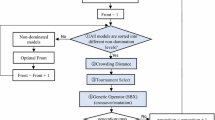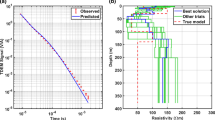Abstract
Despite the robustness of standard genetic algorithms in receiver functions inversion for crustal and uppermost mantle velocity-depth structure, one drawback is that towards the end of a ‘run’, only a few variations in solution ideas are explored. This may lead to the stagnation of the optimization process and can be a major drawback for large model dimensions. To mitigate this problem, we introduced a new selection method that retains the best features of explored models, with an extinction procedure that increases the exploration of the model space through the principle of self-organized criticality. We test the performance of the modified genetic algorithm technique by applying it to the inversion of synthetically generated receiver functions for crustal velocity structure and comparing the results with those obtained using a standard genetic algorithm. The test cases involve using 2 different objective functions, based on the L2 norm and cosine similarity, with 2 different model parameterizations of different model sizes. The results show that our modified genetic algorithm improves the inversion process by consistently obtaining best models with the lowest misfit values and a distribution of best models with less deviations from the true model values. With an improvement of computation time of up to 11.2%, the results suggest that the modified genetic algorithm is best suited to obtain higher accuracy results in shorter computation times which will be especially useful for higher dimension models needing larger pool sizes.
Similar content being viewed by others
Data availability
All synthetic data generated and used in this study can be re-generated following the steps described in this manuscript and are also available from the corresponding author on reasonable request.
The genetic algorithm inversion codes used in this study are available upon request from the authors.
References
Holland, J.H.: Adaptation in Natural and Artificial Systems: An Introductory Analysis with Applications to Biology, Control, and Artificial Intelligence. U Michigan Press (1975)
Sambridge, M., Drijkoningen, G.: Genetic algorithms in seismic waveform inversion. Geophys. J. Int. 109(2), 323–342 (1992)
Gallagher, K., Sambridge, M., Drijkoningen, G.: Genetic algorithms: An evolution from Monte Carlo Methods for strongly non-linear geophysical optimization problems. Geophys. Res. Lett. 18(12), 2177–2180 (1991)
Agostinetti, N.P., Malinverno, A.: Receiver function inversion by trans-dimensional Monte Carlo sampling. Geophys. J. Int. 181(2), 858–872 (2010)
Bodin, T., Sambridge, M., Tkalćić, H., Arroucau, P., Gallagher, K., Rawlinson, N.: Transdimensional inversion of receiver functions and surface wave dispersion. J. Geophys. Res. Solid Earth 117(2), 1–24 (2012)
Langston, C.A.: Structure under Mount Rainier, Washington, inferred from teleseismic body waves. J. Geophys. Res. 84(B9), 4749–4762 (1979)
Ammon, C.J.: The isolation of receiver effects from teleseismic P waveforms. Bull. Seismol. Soc. Am. 81(6), 2504–2510 (1991)
Shibutani, T., Sambridge, M., Kennett, B.: Genetic algorithm inversion for receiver functions with application to crust and uppermost mantle structure beneath Eastern Australia. Geophys. Res. Lett. 23(14), 1829–1832 (1996)
Krink, T., Rickers, P., Thomsen, R.: Applying self-organised criticality to evolutionary algorithms. In: Lecture Notes in Computer Science (Including Subseries Lecture Notes in Artificial Intelligence and Lecture Notes in Bioinformatics), pp. 376–384. Springer (2000)
Krink, T., Thomsen, R.: Self-organized criticality and mass extinction in evolutionary algorithms. In: Proceedings of the IEEE Conference on Evolutionary Computation, ICEC. pp. 1155–61. (2001)
Baker, J.E.: Reducing Bias and Inefficienry in the Selection Algorithm. In: Proceedings of the Second International Conference on Genetic Algorithms. pp. 14–21. (1987)
Baker, J.E.: Adaptive Selection Methods for Genetic Algorithms. In: Proceedings of the 1st International Conference on Genetic Algorithms and their applications. pp. 101–11. (1985)
Goldberg, D.E., Deb, K.: A comparative analysis of selection schemes used in genetic algorithms. Foundations of Genetic Algorithms. 1, 69–93. (1991)
Ahn, C.W., Ramakrishna, R.S.: Elitism-based compact genetic algorithms. IEEE Trans. Evol. Comput. 7(4), 367–385 (2003)
Du, H., Wang, Z., Zhan, W., Guo, J.: Elitism and Distance Strategy for Selection of Evolutionary algorithms. IEEE Access. 6, 44531–44541 (2018)
Greewood, G.W., Fogel, G.B., Ciobanu, M.: Emphasizing extinction in evolutionary programming. Proc. 1999 Congr. Evol. Comput. CEC 1:666–71. (1999)
Marín, J., Solé, R.V.: Macroevolutionary algorithms: A new optimization method on fitness landscapes. IEEE Trans Evol Comput 3(4), 272–286 (1999)
Jaworski, B., Kuczkowski, Ł., Śmierzchalski, R., Kolendo, P.: Extinction Event Concepts for the Evolutionary Algorithms. Prz Elektrotechniczn 88(10), 252–255 (2012)
Newman, M.E.J.: Self-organized criticality, evolution and the fossil extinction record. Proc. R. Soc. Lond. B. 263, 1605–1610 (1996)
Bak, P.: The Discovery of Self-Organized Criticality. In: How Nature Works: The Science of self-organized Criticality, pp. 33–48. Springer New York, New York, NY (1996)
Bak, P., Paczuski, M.: Complexity, contingency, and criticality. Proc Natl Acad Sci 92(15), 6689–6696 (1995)
Frederiksen, A.W., Bostock, M.G.: Modelling teleseismic waves in dipping anisotropic structures. Geophys J Int 141(2), 401–412 (2000)
Shibutani, T., Ueno, T., Hirahara, K.: Improvement in the extended-time multitaper receiver function estimation technique. Bull Seismol Soc Am 98(2), 812–816 (2008)
Helffrich, G.: Extended-time multitaper frequency domain crosscorrelation receiver-function estimation. Bull. Seismol. Soc. Am. 96(1), 344–347 (2006)
Kurita, T.: Regional variations in the structure of the crust in the Central United States from P-wave spectra. Bull. Seismol. Soc. Am. 63(5), 1663–1687 (1973)
Acknowledgements
The authors would like to thank Professor Andrew Frederiksen for his useful advice on RAYSUM, as well as Mopati Basner Mmereki for improving the wording in this manuscript. Some figures in this manuscript were generated using the Seismic Analysis Code (SAC).
Funding
No funding was received for conducting this study.
Author information
Authors and Affiliations
Contributions
APM was responsible for the conceptualization of the study, the data synthesis, coding and method testing as well as analysis of the results and drafting the manuscript, while TS supervised this study and was involved in the analysis as well as reviewing and editing the manuscript. All authors read and approved the final manuscript.
Corresponding author
Ethics declarations
Competing interests
The authors declare that they have no competing interests.
Additional information
Publisher’s Note
Springer Nature remains neutral with regard to jurisdictional claims in published maps and institutional affiliations.
Rights and permissions
Springer Nature or its licensor (e.g. a society or other partner) holds exclusive rights to this article under a publishing agreement with the author(s) or other rightsholder(s); author self-archiving of the accepted manuscript version of this article is solely governed by the terms of such publishing agreement and applicable law.
About this article
Cite this article
Mpuang, A.P., Shibutani, T. Improvements in the genetic algorithm inversion of receiver functions using extinction and a new selection approach. Comput Geosci (2024). https://doi.org/10.1007/s10596-024-10283-0
Received:
Accepted:
Published:
DOI: https://doi.org/10.1007/s10596-024-10283-0




